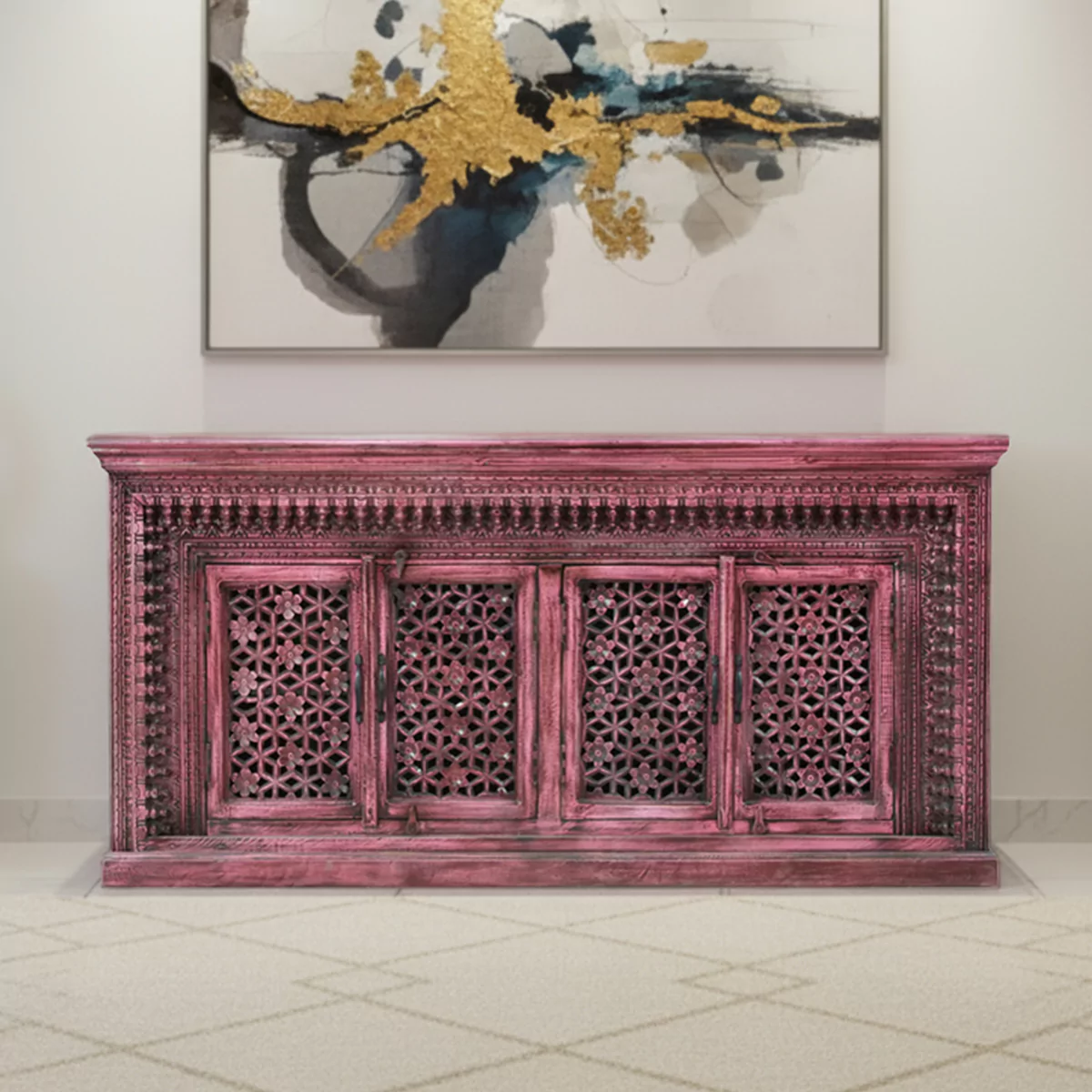A sideboard with storage offers the perfect blend of style and functionality for your dining room. Rather than letting plates, cutlery, and serving dishes clutter your dining table or kitchen counters, a well-chosen sideboard provides dedicated space for all your dining essentials while enhancing your room’s aesthetic appeal.
Whether you’re hosting dinner parties or simply want to keep your everyday dinnerware organized, the right sideboard for plates and cutlery can transform how you store and access your dining essentials. From rustic wooden designs to sleek modern pieces, today’s sideboards offer various storage solutions including drawers, shelves, and compartments specifically designed for tableware.
This guide highlights the top sideboard options that excel in both storage capacity and visual appeal. We’ll explore key features to consider, showcase five outstanding models that cater to different styles and needs, and provide practical tips for incorporating your new sideboard into your dining room layout. By the end, you’ll have everything you need to choose the perfect sideboard with storage for your home.
Why Choose a Sideboard with Storage for Dining Essentials?
A sideboard for dining room use solves multiple storage challenges while serving as an attractive focal point. Unlike kitchen cabinets that often become overcrowded, a dedicated dining room sideboard with storage keeps your finest dishes, serving platters, and table linens easily accessible yet neatly organized.
The primary benefit lies in convenience. Having plates, cutlery, napkins, and serving pieces within arm’s reach of your dining table streamlines meal preparation and cleanup. This proximity eliminates the need to constantly travel between the kitchen and dining room, especially useful when entertaining guests.
From an aesthetic standpoint, sideboards add visual weight and balance to dining rooms. They provide horizontal lines that complement vertical elements like dining chairs and wall art, creating a more cohesive room design. Many homeowners find that a well-styled sideboard becomes a natural display area for decorative items, family photos, or seasonal arrangements.
Organization benefits extend beyond mere storage. Quality sideboards feature specialized compartments that protect delicate items from chips and scratches. Drawers with dividers keep cutlery sorted, while adjustable shelves accommodate plates of various sizes.
Key Features to Look for in a Storage Sideboard
When selecting a sideboard cabinet with drawers, understanding the different storage options helps you choose the most functional design for your needs. The choice between drawers and shelves significantly impacts how you’ll use your sideboard daily.
Drawers excel at storing smaller items like cutlery, napkins, and table accessories. Look for sideboards with deep drawers that can accommodate serving utensils and even small serving dishes. Soft-close mechanisms prevent slamming and protect both the furniture and your stored items.
Shelves work better for plates, bowls, and larger serving pieces. Adjustable shelves offer flexibility as your storage needs change, while fixed shelves typically provide more stability for heavier items. Consider the spacing between shelves—you’ll want adequate height for stacking dinner plates while keeping them easily accessible.
The door style affects both functionality and aesthetics. Glass doors showcase beautiful dishes while protecting them from dust, making them ideal for special occasion dinnerware. Solid doors hide everyday items and create a cleaner, more streamlined appearance. Some buffet cabinet with storage models combine both options, offering the best of both worlds.
Material quality directly impacts durability and longevity. Solid wood construction handles the weight of dishes better than particle board or laminate options. Metal hardware, including hinges and drawer slides, should feel sturdy and operate smoothly.
Best Sideboards with Storage for Plates and Cutlery
1. Briventa Rustic Wooden Sideboard with Black Metal Frame
The Briventa sideboard combines rustic charm with modern functionality through its solid acacia wood construction and sleek black metal frame. Measuring 57″ L x 18″ W x 32″ H, this piece offers substantial storage without overwhelming smaller dining rooms.
The design features two doors and two drawers plus an open display shelf, providing versatile storage options. The open shelf works perfectly for frequently used serving pieces or decorative items, while the enclosed storage keeps everyday dishes organized and dust-free. Metal legs and handles create visual contrast against the natural wood finish.
The solid acacia wood construction ensures this sideboard can handle heavy dinnerware loads while developing a beautiful patina over time. The metal frame adds industrial appeal that works well in both modern and transitional dining rooms.
2. Crestora Dual-Tone Modern Solid Wood Sideboard
For those seeking contemporary style, the Crestora sideboard delivers with its striking chevron pattern and dual-tone finish combining natural and black elements. At 55″ L x 16″ W x 33″ H, it fits comfortably in most dining spaces while providing ample storage.
The configuration of two doors and three drawers maximizes storage efficiency. The multiple drawers are particularly useful for organizing different types of cutlery and table accessories, while the cabinet space accommodates plates and serving dishes of various sizes.
Constructed from solid mango and acacia wood, this sideboard offers both durability and visual interest. The chevron pattern adds texture and movement to the design, making it a standout piece that can anchor your dining room’s aesthetic.
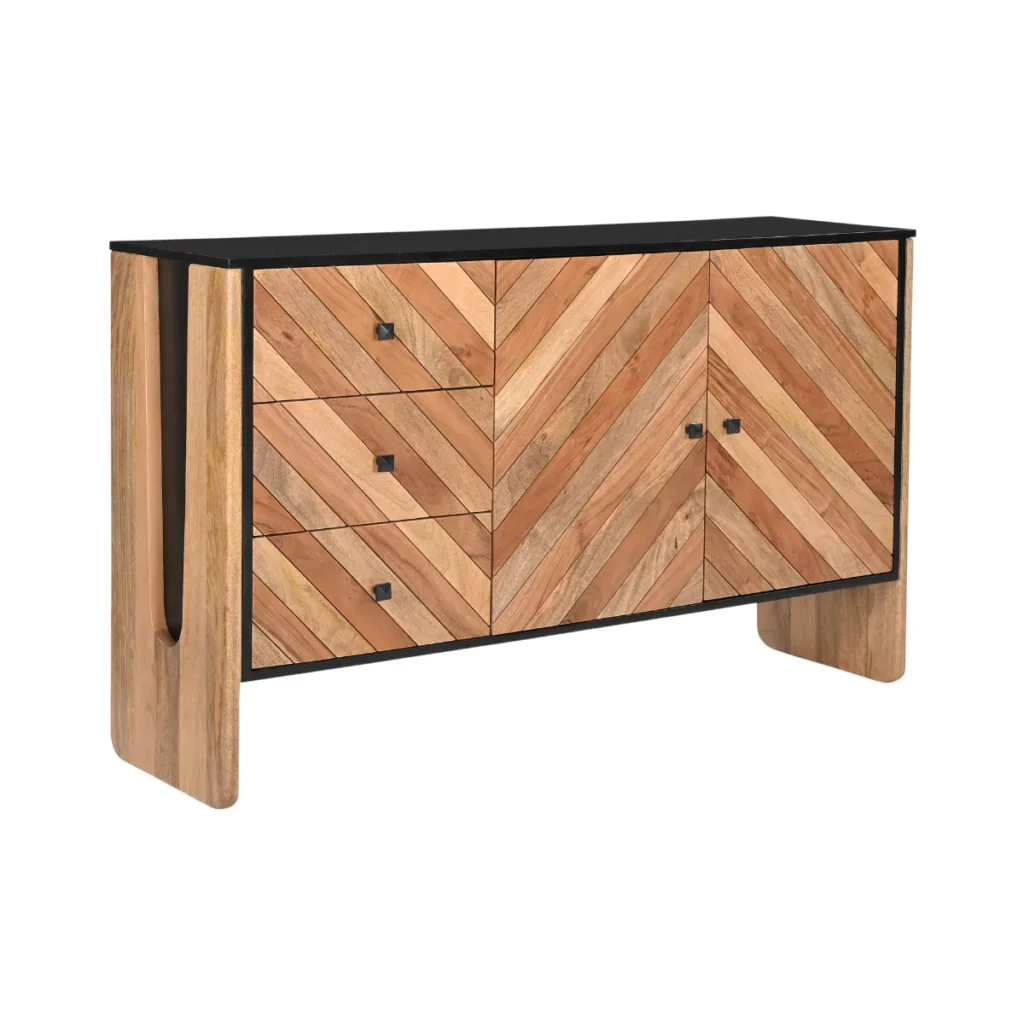
Mirevana Two-Tone Modern Solid Wood Sideboard
The Mirevana sideboard offers maximum storage capacity with its impressive six-drawer configuration plus two doors. Measuring 67″ L x 18″ W x 33″ H, this is the largest option in our selection, ideal for families who entertain frequently or have extensive dinnerware collections.
The combination of mango wood and stone veneer creates sophisticated visual appeal, while the natural and grey finish palette works with various decorating styles. Metal handles and legs provide contemporary touches that elevate the overall design.
Each door features a middle shelf, effectively creating four separate storage compartments within the cabinet space. This thoughtful design helps organize different types of dishes while keeping them easily accessible.
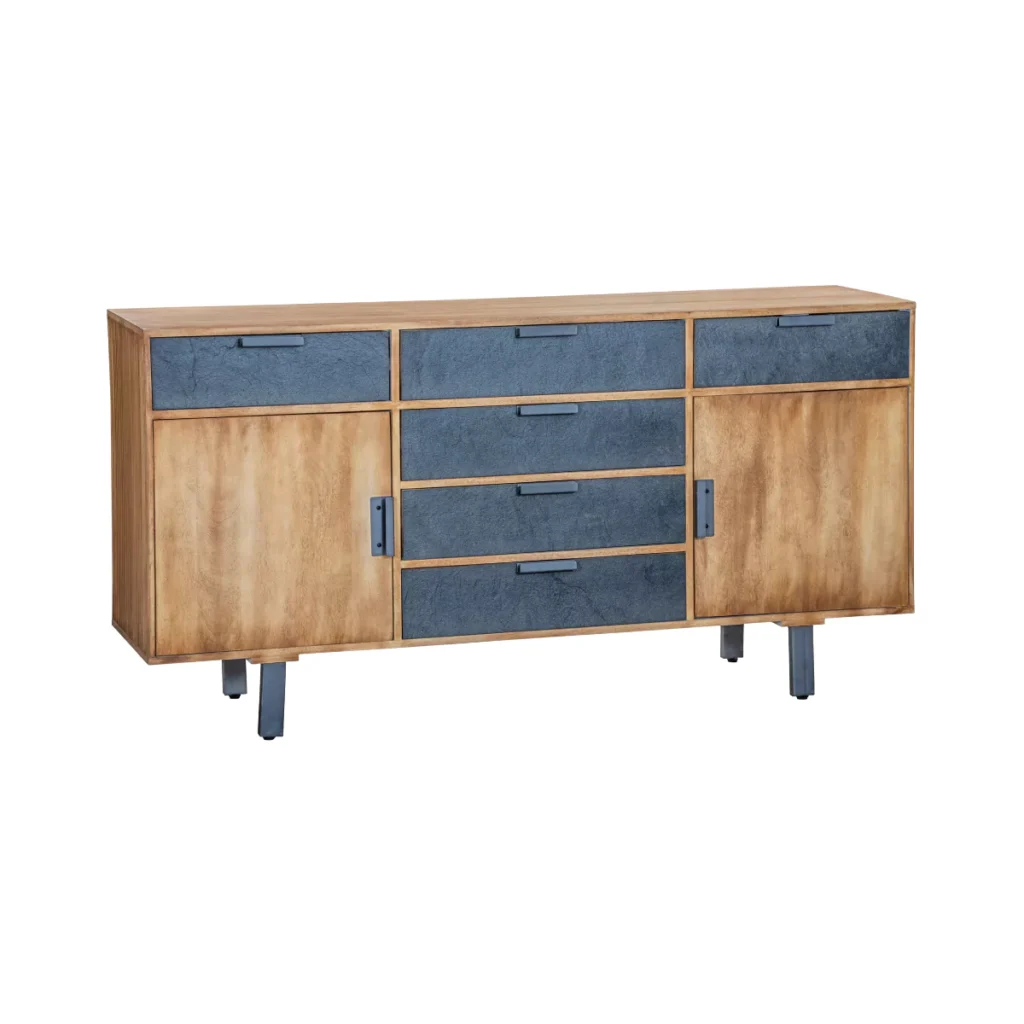
3. Evorence Traditional Solid Wood Sideboard
The Evorence sideboard appeals to those who prefer classic styling with its traditional design elements. Crafted from mango and pine wood with a natural finish, this 59″ L x 16″ W x 35″ H piece offers timeless appeal that complements both traditional and farmhouse dining rooms.
The two-door, three-drawer configuration provides balanced storage options. The slightly taller height (35″) compared to other models creates more vertical storage space while maintaining proportions that work well with standard dining room furniture.
The all-natural wood finish allows the material’s grain patterns to show through, creating a piece that will age beautifully over time. This sideboard works particularly well in homes with other natural wood furniture pieces.
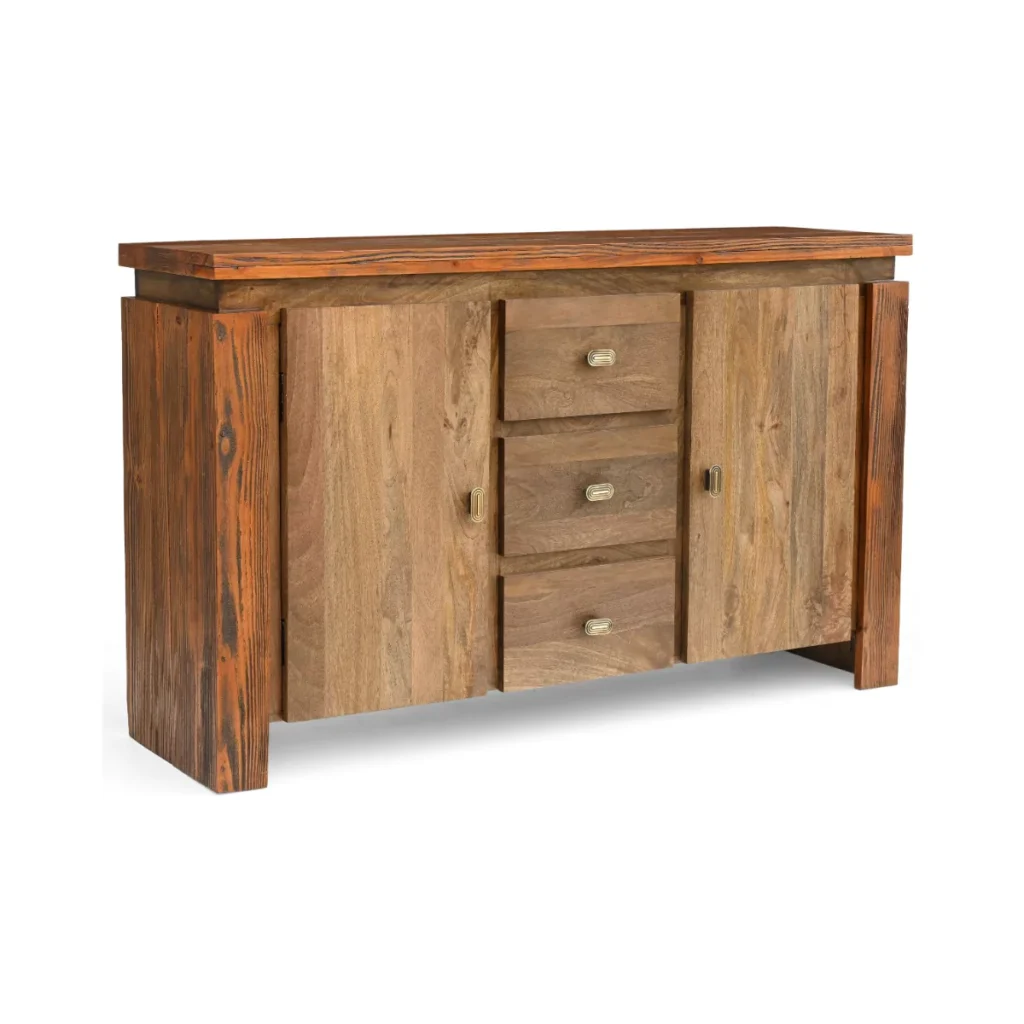
4. Cirevana Mid-Century 4-Door Large Wooden Sideboard
The Cirevana sideboard embraces mid-century modern design principles with its clean lines and four-door configuration. At 69″ L x 18″ W x 30″ H, it’s the longest option while maintaining a lower profile that emphasizes horizontal lines.
The four-door design without drawers creates large, unobstructed storage compartments perfect for bigger items like serving platters, large bowls, and bulky serving pieces. This configuration also allows for easier cleaning and organization of storage spaces.
Constructed entirely from acacia wood with a natural finish, this sideboard showcases the wood’s natural beauty while providing the structural integrity needed for heavy dinnerware storage.
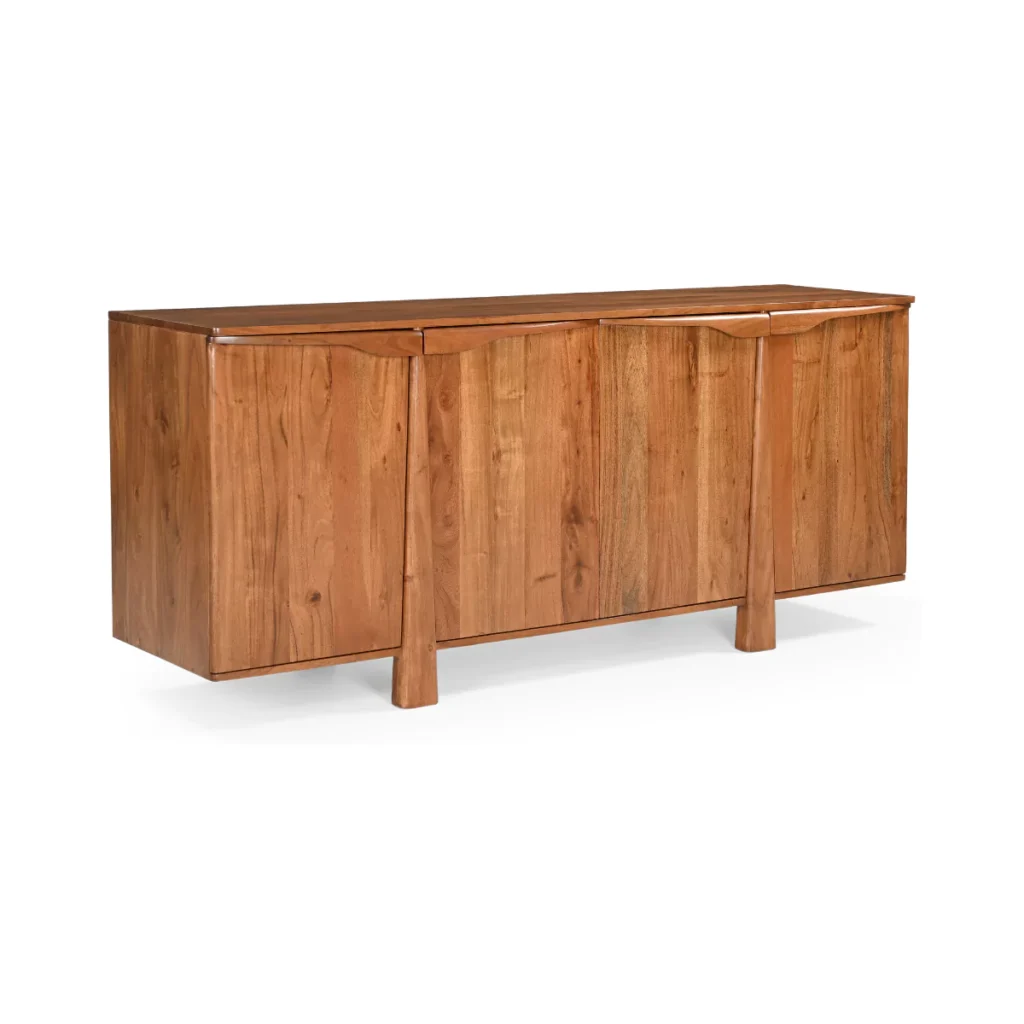
Explore our collection of solid wood sideboards.
How to Style and Place Your Sideboard in the Dining Room
Proper placement of your dining room sideboard with storage enhances both functionality and visual appeal. Position the sideboard along a wall where it won’t interfere with traffic flow around your dining table. A general rule suggests leaving at least 36 inches between the sideboard and dining table to allow comfortable movement.
The sideboard’s height should complement your dining table proportions. Most dining tables stand 28-30 inches high, so a sideboard between 32-36 inches creates pleasing visual balance. If your sideboard is significantly lower, consider adding height through artwork or decorative elements placed on top.
Lighting plays a crucial role in showcasing your sideboard and making stored items easily accessible. Table lamps placed on either end create ambient lighting for dining, while under-cabinet lighting can illuminate the contents when doors are open. Wall-mounted sconces above the sideboard provide both task and accent lighting.
Decorative styling transforms your sideboard from pure storage into a design focal point. Create visual interest through layering—place larger items like vases or artwork in the back, medium-height objects in the middle, and smaller accessories in front. This creates depth and prevents the surface from appearing flat.
Consider the 60-30-10 color rule when styling your sideboard. Use your room’s dominant color for 60% of the styling elements, a secondary color for 30%, and an accent color for the remaining 10%. This creates cohesive styling that ties into your overall room design.
Making the Right Choice for Your Storage Needs
Selecting the perfect sideboard with storage requires balancing your specific storage requirements with your dining room’s dimensions and style. Start by inventorying what you need to store—count your plates, bowls, serving pieces, and cutlery sets to determine the storage capacity you need.
Consider your entertaining style when choosing between drawer-heavy and shelf-heavy designs. If you frequently host large gatherings, prioritize models with more shelf space for serving pieces. For everyday organization, more drawers might serve you better by keeping smaller items sorted and easily accessible.
Room proportions should guide your size selection. In smaller dining rooms, choose sideboards that don’t exceed two-thirds of your dining table’s length. Larger spaces can accommodate longer sideboards that create substantial visual presence.
Quality indicators include solid wood construction, smooth-operating hardware, and attention to joinery details. These elements ensure your investment will withstand daily use while maintaining its appearance over time.
Take time to explore different options and consider how each sideboard’s features align with your specific needs. The right choice will serve your family for years while enhancing your dining room’s functionality and style.

